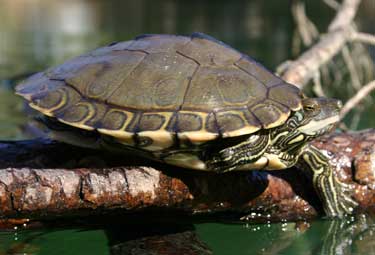August 30, 2010
New Turtle Species Discovered in USA

The Pearl Map Turtle, (Graptemys pearlensis) is found in the Pearl River in Louisiana and Mississippi. Graptemys means “map turtle” in Greek, and are so named for the map-like pattern of light colored lines often seen on their shells. Pearlensis means “from the pearl” in Latin, referencing the river this turtle calls home.
Northern Arizona University has released the following news of the discovery of a new turtle in the USA:
When scientists announce the discovery of a new animal species, we often imagine exotic, difficult to reach locations—the untouched shore of a distant island, the forests of the rain-drenched Amazon or the darkest depths of the Arctic Ocean.
But the recent announcement of a new species of turtle in the southeastern United States proves that even in a country considered to be well-explored, perhaps more awaits discovery.
In June, Jeff Lovich, NAU adjunct faculty member in biology, and Josh Ennen, NAU affiliate, published the discovery of a new species of turtle in Chelonian Conservation and Biology International Journal of Turtle and Tortoise Research.
Found in the Pearl River, which flows through Mississippi and Louisiana before it meets the Gulf of Mexico, the newly named Pearl Map Turtle, or Graptemys pearlensis, had been mistaken for a turtle native to the neighboring Pascagoula River. Ennen found it odd that the Pascagoula Map Turtle was found in both rivers and wanted to further investigate.
Ennen was completing his dissertation at University of Southern Mississippi when he decided to take a closer look at the inhabitants of the two rivers. His research led him to Lovich, who had found, described and named the last turtle species in the same region in 1992.
“I was familiar with Jeff’s work when questions started coming up,” Ennen said. “Based on the genetics, morphology and geographic isolation, I was considering classifying the turtles as distinct population segments when I decided to contact Jeff.”
Lovich, a research ecologist with U.S. Geological Survey’s Colorado Plateau Station at NAU, shared his findings and insight as the scientists built their case for classification of the new turtle species. His access to geologic and geographic data with the USGS assisted in their developing theory that the turtles had evolved into a separate species.
“You’d expect to see similar aquatic species in these rivers due to their proximity,” Lovich said. “However, with sea level changes associated with glacial and interglacial periods in the past, animals in these rivers were periodically separated for tens of thousands to millions of years.”
Ennen and Lovich observed pattern variations between turtles in two rivers, and examining their DNA verified that the turtle endemic to each river was a different species.
The announcement of the Pearl Map Turtle, “Genetic and morphological variation between populations of the Pascagoula Map Turtle (Graptemys gibbonsi) in the Pearl and Pascagoula Rivers with description of a new species,” brings the number of native turtle species in the United States to 57, including six in Arizona, with approximately 320 species documented worldwide.
 About Loren Coleman
About Loren Coleman
Loren Coleman is one of the world’s leading cryptozoologists, some say “the” leading living cryptozoologist. Certainly, he is acknowledged as the current living American researcher and writer who has most popularized cryptozoology in the late 20th and early 21st centuries.
Starting his fieldwork and investigations in 1960, after traveling and trekking extensively in pursuit of cryptozoological mysteries, Coleman began writing to share his experiences in 1969. An honorary member of Ivan T. Sanderson’s Society for the Investigation of the Unexplained in the 1970s, Coleman has been bestowed with similar honorary memberships of the North Idaho College Cryptozoology Club in 1983, and in subsequent years, that of the British Columbia Scientific Cryptozoology Club, CryptoSafari International, and other international organizations. He was also a Life Member and Benefactor of the International Society of Cryptozoology (now-defunct).
Loren Coleman’s daily blog, as a member of the Cryptomundo Team, served as an ongoing avenue of communication for the ever-growing body of cryptozoo news from 2005 through 2013. He returned as an infrequent contributor beginning Halloween week of 2015.
Coleman is the founder in 2003, and current director of the International Cryptozoology Museum in Portland, Maine.
Email • Facebook • Twitter •
Filed under Breaking News, CryptoZoo News, New Species

